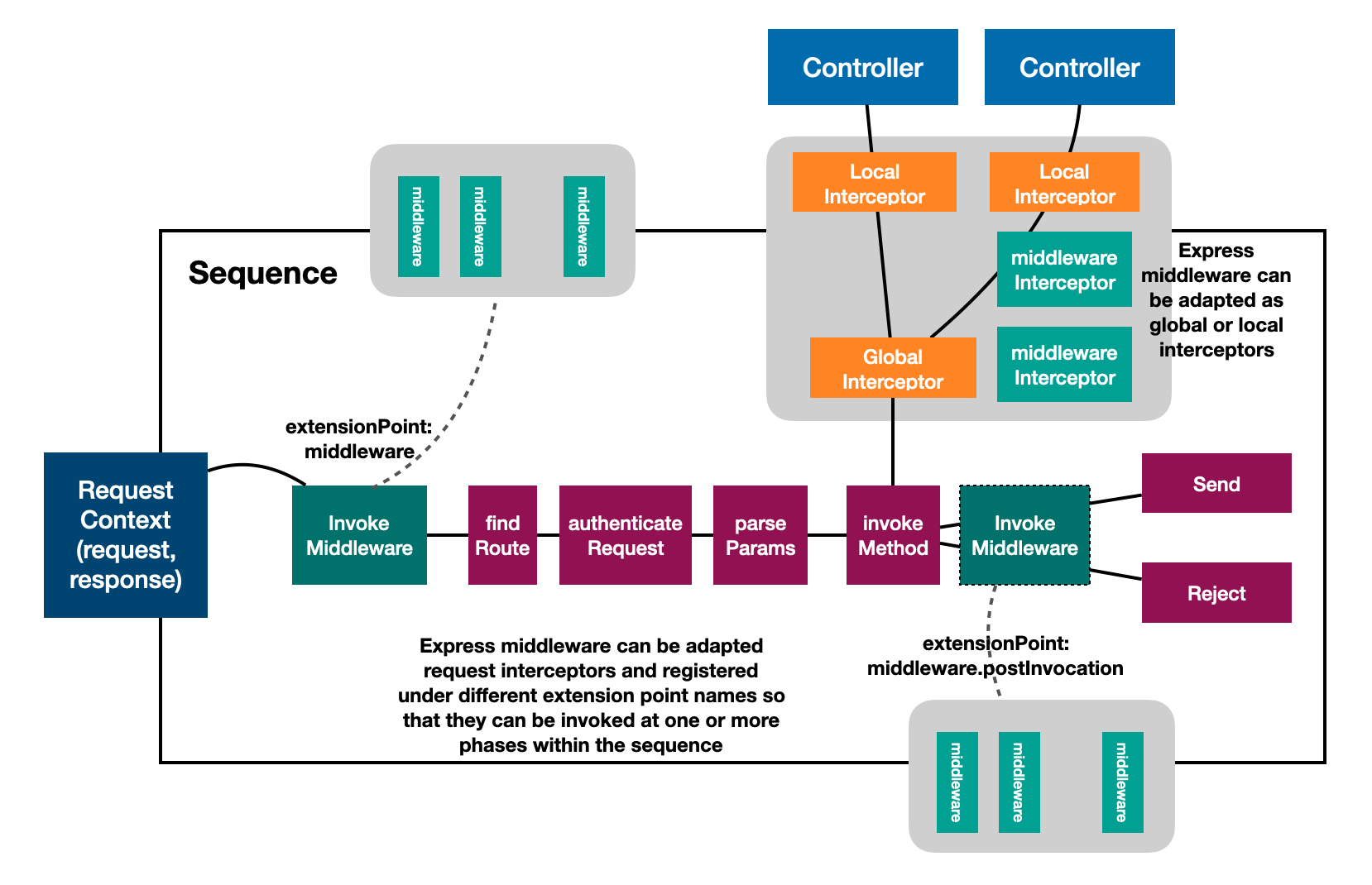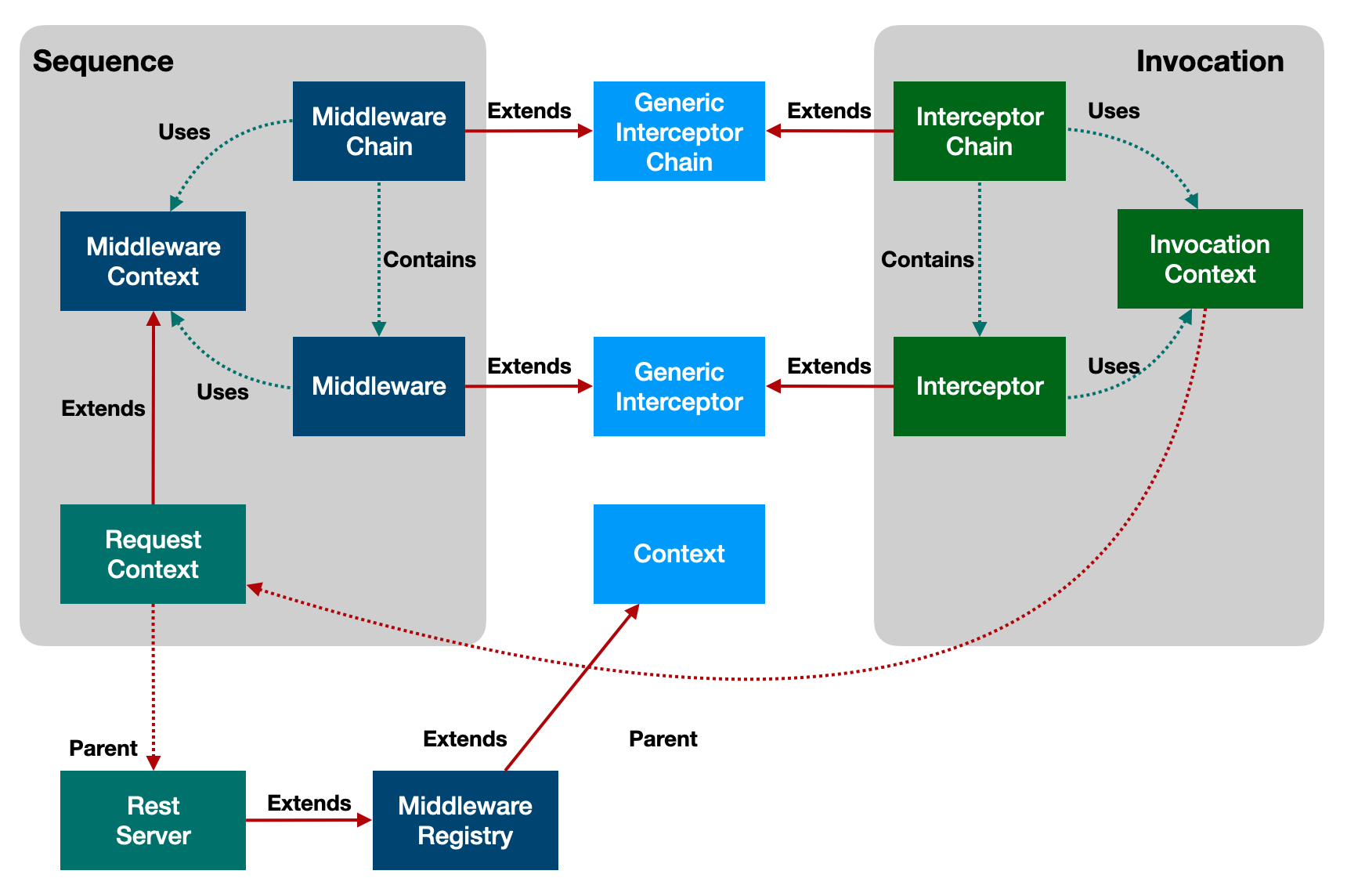Overview
Node.js web frameworks such as Express and Koa use middleware as the basic
building blocks to compose a pipeline of functions that handles HTTP requests
and responses.
LookBack 4 leverages Express behind the scenes for its REST server implementation. We decided to not expose Express’s native middleware capabilities to users while we pursue an elegant and non-invasive way to fit Express middleware into the LoopBack 4 programming model nicely. Meanwhile, we have received various requests and questions from our users on how to use Express middleware with LoopBack 4 or migrate their usage of Express middleware from LoopBack 3 to LoopBack 4.
We agree that middleware is a powerful construct for LoopBack developers. Being able to reuse the great assets from Express’s middleware ecosystem is a critical objective. It’s also very important to fully leverage LoopBack’s extensibility and composability to plug middleware into the framework. Let’s look at some of key perspectives to map use cases to our design.
Design goals
The core of LoopBack is built upon patterns of Inversion of Control, Dependency Injection, as well as Extension Point and Extensions.
-
Open up the Sequence to expose extension points that allow custom logic, such as logging, monitoring, and rate limiting, to be plugged in as middleware for http request/response processing. It should be possible to contribute middleware without requiring manual update of the
Sequenceclass. Components should be able to leverage dependency injection to externalize the configuration. For example, we can build a Helmet component for LoopBack to add security protection middleware to our Sequence. - Embrace and adapt existing Express middleware modules with minimal effort
- Run an explicit list of Express middleware handler functions
- Support the factory and configuration pattern used by most Express middleware
- Register middleware in any order with the ability to control the order of execution
- Allow configuration to be updated at runtime by simply rebinding the configuration value and make it possible for the middleware to pick up. For example, adjust logging level from info to debug if necessary.
- Allow Express middleware to used with LoopBack in two tiers:
- As middleware in the sequence to handle all requests/responses
- As global or local interceptors around controller method invocations
- Build on top of the Interceptors infrastructure. We have
used interceptors within the
InvokeMethodaction of a sequence. Expanding such capability to other actions is a natural choice. We’re not reinventing the wheel as we are just extending the interceptor idea to new use cases.The Middleware and MiddlewareChain are not new concepts. They are just specialization of GenericInterceptor and GenericInterceptorChain. Being able to use the same programming model concepts for different tiers provide the consistency and ease of learning.
LoopBack style middleware
Built on top of idea of interceptors, middleware is specialized functions that
work with the MiddlewareContext - a wrapper object for request and
response. The signature is of Middleware is:
import {MiddlewareContext} from '@loopback/rest';
import {Next, ValueOrPromise, InvocationResult} from '@loopback/core';
(context: MiddlewareContext, next: Next) => ValueOrPromise<InvocationResult>;
For example, a simple logging middleware can be created and registered as follows.
src/middleware/log.middleware.ts
const log: Middleware = async (middlewareCtx, next) => {
const {request} = middlewareCtx;
console.log('Request: %s %s', request.method, request.originalUrl);
try {
// Proceed with next middleware
const result = await next();
// Process response
console.log(
'Response received for %s %s',
request.method,
request.originalUrl,
);
return result;
} catch (err) {
// Catch errors from downstream middleware
console.error(
'Error received for %s %s',
request.method,
request.originalUrl,
);
throw err;
}
};
app.middleware(log);
Why not use Express middleware as-is?
You may wonder why we don’t expose Express middleware directly. There are some gaps in Express middleware that we would like to close to better align with LoopBack’s architecture.
- Express middleware are one-way handlers that mostly process requests and
there is no first-class facility to handle responses. We would love to
support
Koa style middleware
that use
async/awaitto allow cascading behaviors. - Express middleware are added by the order of
app.use()and it’s hard to contribute middleware from other modules. - Express does not allow dependency injection. We would like to enable injection of middleware configurations.
To harvest the best of breeds of both frameworks, we build the integration on top of the interceptor with community input as illustrated in the diagram below:

In the diagram, a specialized type of interceptors is introduced as Middleware
for LoopBack. Our middleware is basically a function with the signature:
(context: MiddlewareContext, next: Next) => ValueOrPromise<InvocationResult>;
LoopBack organizes middleware into one or more extension points exposed by
InvokeMiddleware providers. Middleware are registered as extensions. Within
the sequence, when invokeMiddleware is executed, a chain is formed with
discovered middleware, which are then invoked in a cascading fashion.
Please note that Middleware and related concepts are inherited from
interceptors.

Introduce middleware to REST sequence of actions
There are a few actions involved in the default sequence. See Sequence.md for
more details.
It’s often desirable to reuse Express middleware in the sequence to handle API
requests/responses without reinventing the wheel. We now add an
InvokeMiddleware action as the first step in the default sequence. The action
itself is an interceptor chain of MiddlewareContext. It uses the powerful
extension point/extension pattern to
discover registered Express middleware and invoke them as a chain.
Default sequence
The generated src/sequence.ts now has a new middleware property in
DefaultSequence to allow injection of the middleware chain while maintaining
backward compatibility of the constructor.
src/sequence.ts
export class DefaultSequence implements SequenceHandler {
/**
* Optional middleware chain
* Invokes registered middleware (injected via SequenceActions.MIDDLEWARE).
*/
@inject(SequenceActions.MIDDLEWARE, {optional: true})
protected invokeMiddleware: InvokeMiddleware = () => false;
// ...
async handle(context: RequestContext): Promise<void> {
try {
const {request, response} = context;
const finished = await this.invokeMiddleware(context);
if (finished) return;
const route = this.findRoute(request);
const args = await this.parseParams(request, route);
const result = await this.invoke(route, args);
debug('%s result -', route.describe(), result);
this.send(response, result);
} catch (error) {
this.reject(context, error);
}
}
}
Extend sequence with more than one middleware actions
Sometimes we want to add middleware to the sequence in between other actions,
for example, do some post-processing before the result is written to the HTTP
response. This can be achieved by overriding the sequence implementation to call
invokeMiddleware as needed.
src/sequence.ts
export class SequenceWithMiddleware extends DefaultSequence {
async handle(context: RequestContext): Promise<void> {
try {
const {request, response} = context;
// The default middleware chain
let finished = await this.invokeMiddleware(context);
if (finished) return;
const route = this.findRoute(request);
const args = await this.parseParams(request, route);
const result = await this.invoke(route, args);
// The result from the invocation can be bound to the request context
// so that downstream middleware can receive the value via dependency
// injection or context lookup
context.bind('invocation.result').to(result);
// The second middleware chain for post-invocation processing
// POST_INVOCATION_MIDDLEWARE is the name of the extension point
// for post-invocation middleware
finished = await this.invokeMiddleware(context, {
extensionPoint: POST_INVOCATION_MIDDLEWARE,
});
if (finished) return;
this.send(response, result);
} catch (error) {
this.reject(context, error);
}
}
}
It’s also possible to inject multiple instances of InvokeMiddleware, each of
which has its own extension point name.
src/sequence.ts
export class SequenceWithMiddleware extends DefaultSequence {
/**
* Optional middleware chain
* Invokes registered middleware (injected via SequenceActions.MIDDLEWARE).
*/
@inject('middleware.postInvoke', {optional: true})
protected middlewarePostInvoke: InvokeMiddleware = () => {};
async handle(context: RequestContext): Promise<void> {
try {
const {request, response} = context;
// The default middleware chain
await this.invokeMiddleware(context);
const route = this.findRoute(request);
const args = await this.parseParams(request, route);
const result = await this.invoke(route, args);
// The second middleware chain for post-invocation processing
await this.middlewarePostInvoke(context);
this.send(response, result);
} catch (error) {
this.reject(context, error);
}
}
}
Now we can set up applications to leverage the new sequence:
src/application.ts
export class MyApplication extends RestApplication {
constructor(config: ApplicationConfig) {
// Create another middleware phase. This is NOT needed if we call the same
// `invokeMiddleware()` with different extension point (chain) names.
this.bind('middleware.postInvoke')
.toProvider(InvokeMiddlewareProvider)
.tag({[CoreTags.EXTENSION_POINT]: POST_INVOCATION_MIDDLEWARE});
this.sequence(SequenceWithMiddleware);
// Register a middleware
// `spy` is the factory function of a middleware
//
const spyBinding = this.expressMiddleware(
spy,
undefined, // configuration will be needed here as we bind it to the context
{
key: 'middleware.spy',
extensionPointName: POST_INVOCATION_MIDDLEWARE,
},
)
// Set the scope to be `TRANSIENT` so that the new config can be loaded
.inScope(BindingScope.TRANSIENT);
this.configure<SpyConfig>(spyBinding.key).to({action: 'log'});
}
}
Register middleware to be executed by InvokeMiddleware actions
To use existing Express middleware, please check out Using Express Middleware.
src/application.ts
import {ApplicationConfig} from '@loopback/core';
import {RestApplication} from '@loopback/rest';
import {log} from './middleware/log.middleware';
export class MyApplication extends RestApplication {
constructor(config: ApplicationConfig) {
this.middleware(log);
}
}
Middleware can also be contributed using components.
import morgan from 'morgan';
import {Component} from '@loopback/core';
import {
createMiddlewareBinding,
defineInterceptorProvider,
} from '@loopback/express';
const binding = createMiddlewareBinding(defineInterceptorProvider(morgan));
class MyComponent implements Component {
bindings = [binding];
}
app.configure(binding.key).to({});
app.component(MyComponent);